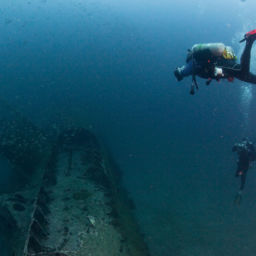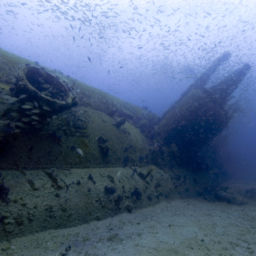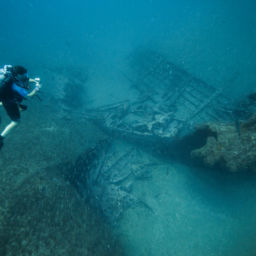From January to the end of August 1942, German U-boats attacked more than 285 vessels in North American waters. Just off coastal North Carolina, the remnants of many of these ships are scattered on the ocean floor. The remains of this little-known battlefield serve as the final resting place for 90 ships and nearly 1,700 men lost during the Battle of the Atlantic. Over the course of the battle, eight Allied convoy vessels, 78 merchant freighters and tankers and four German U-boats sank off North Carolina’s coast. Each shipwreck tells a unique story; today we visit the Tamaulipas.
Tamaulipas sinks
Tamaulipas operated on a route from Tampico, Mexico, to the United States, carrying petroleum products to refineries on the East Coast. On April 9, 1942, Tamaulipas was traveling alone and unarmed on its way to New York City, carrying a full cargo of 70,000 barrels of oil.
Early that morning as Tamaulipas passed Cape Lookout, North Carolina, a lookout spotted the wake of a torpedo as it crossed the tanker’s wake. Trying to avoid a torpedo strike, Tamaulipas’s captain quickly made an adjustment to travel in a zig-zag course, but it was for naught. U-552 fired a second torpedo that exploded into Tamaulipas’s starboard side, aft the midship house, and near the No. 5 tank. U-552 had a successful morning as it had also just attacked and sunk another tanker, Atlas.
The explosion and resulting eruption of the flammable cargo broke Tamaulipas in half. Within five minutes of the attack, the captain realized the ship was lost and ordered the crew to abandon ship. Two crew members died in the explosion, but the surviving crew made it into the No. 1 and No. 3 lifeboats and escaped from the tanker with burning oil quickly surrounding them atop the water. A few hours after the attack, the HMS Norwich City picked up 35 surviving crew members, where they joined the surviving crew from Atlas.
Diving Tamaulipas
The wreck of Tamaulipas is in two sections, resting in about 155 feet (47 m) of water off Cape Lookout, North Carolina. The vessel broke in two, but only after floating for some time in the current. Therefore, the two halves of the ship are located about half-mile away from one another.
The ship’s forward section is turtled, with the outer hull pointing toward the surface. Half a mile to the north, the aft section of Tamaulipas sits upright on the seabed, with numerous identifiable features. This section is contiguous and easily navigable. Large amounts of disarticulated hull and deck structure surround the engine and two boilers. The propeller and rudder are also visible. The distinct fantail stern is lying to its starboard side, with part of the steering quadrant located adjacent to this structure.
“Diving on the stern section is magnificent as it sits upright with a very prominent fantail,” says NOAA maritime archaeologist Joe Hoyt.
“For those who love to see sharks, the large steering quadrant and the engineering space are usually covered in them. It’s a great dive with clear, warm water. Although I have never been diving on the bow section, multibeam sonar shows that it rests upside down. Another enticing factor to dive on this wreck is its location. The site is not frequented as often as other shipwrecks, so it’s more pristine, and you know you are seeing something that many don’t have the opportunity to see.”
To learn more about Tamaulipas and other World War II shipwrecks off the North Carolina coast, click here.
An expanded sanctuary
In an effort to honor the service and sacrifice of those lost during the Battle of the Atlantic, NOAA in 2019 will release a draft proposal to expand the boundaries of Monitor National Marine Sanctuary to include a nationally significant collection of shipwrecks that currently have little or no legal protection. The expansion would also establish the largest area designated as a World War II battlefield anywhere in the world. Tamaulipas is one vessel included in the proposal.
To learn more about the proposal, click here.

















